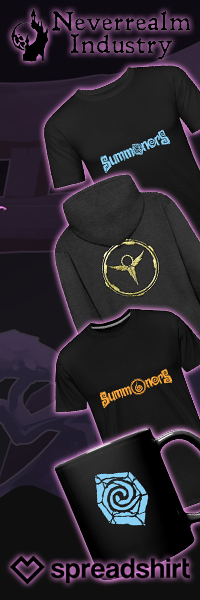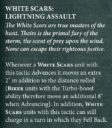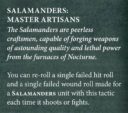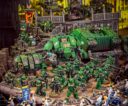Warhammer 40k: Weitere Codex Space Marine Previews
Games Workshop zeigen weitere Previews für den kommenden Codex: Space Marines, mit den White Scars und Salamanders und auch eine Übersicht von sieben enthaltenen Orden, sowie Tipps zum Einsatz dieser Orden für die eigenen Space Marine Armeen.
Chapter Focus: White Scars
In today’s Chapter Focus we’re looking at the White Scars, peerless masters of the hunt. Similar in some respects to the Raven Guard (who we previewed yesterday), the White Scars exchange the stealth of their brethren for unparalleled speed.
The savage appearance of the White Scars belies an intelligent, measured approach to war; every brutal attack is the culmination of careful planning and reconnaissance. Attacking with primal fury, the White Scars are a storm from which there is no escape. On the tabletop, this is reflected by the White Scars’ Chapter Tactic, Lightning Assault. Firstly, all White Scars biker units move faster when advancing, allowing you to close in on the foe and outflank your enemies. Secondly, all White Scars units – including Dreadnoughts! – can charge in the same turn that they fall back. This is huge, effectively allowing the White Scars to guarantee priority in assaults and letting powerful close combat units engage and re-engage at will without getting bogged down.
This is going to be deadly with Reivers, who, as we’ve mentioned in their tactica, can use Shock Grenades to prevent enemies from firing Overwatch, or stymie units that inflict damage when they charge such as the Ironclad Dreadnought and Assault Centurions. Inceptors, in particular, are one of the most dangerous units that a White Scars general can field, capable of shooting and charging when they fall back thanks to having both Fly and the White Scars Chapter Tactic. Jaghatai Khan would be proud!
As well as Chapter Tactics, there’s a range of ways to further customise your White Scars. Kor’sarro Khan is as powerful as he ever was, and his unique ability For the Khan! boosts the Strength of charging White Scars units – combined with their Chapter Tactics, it’s going to be very hard to defend against getting repeatedly charged by a White Scars army. The White Scars Stratagem, Born in the Saddle, allows White Scars bikers to advance, shoot, and charge, meaning that each biker has a potential threat range of 26″, and you’ll be able to hit your opponent hard before they’re even able to react.
Finally, the White Scars have a unique Warlord Trait and Relic adding yet more powerful options to the army. Deadly Hunter allows your Warlord to deal mortal wounds when charging, while the Mantle of the Stormseer makes it easier for White Scars psykers to cast Smite and unleash the power of the storm.
Und auch hier fassen wir für euch kurz die wichtigsten Punkte kurz zusammen.
- Ordensfähigkeit der White Scars addieren 2 Zoll auf die Bewegung beim Vorrücken, außerdem dürfen Einheiten die zurückfallen in der selben Runde nochmal angreifen
- Der White Scar Kommandopunkt erlaubt es Bikes vorzurücken, zu schießen und anzugreifen, wodurch die potentielle Bedrohungsreichweite auf 26 Zoll steigt
- Die Kriegsherren Fähigkeit verteilt tödliche Wunden beim Angriff und das Relikt erleichtert einem Pioniker Schmetterschlag anzuwenden
Chapter Focus: Salamanders
Using speed, stealth or tactics to defeat your foes is one thing, but incinerating them, while less subtle, is just as effective. In today’s Chapter Focus, we’re looking at the Salamanders, stoic paragons of strength, honour and flamecraft. We’ve already taken a first look at the Salamanders Chapter Tactic, but today, we’re taking a deep dive into how this works with the rest of your army and other powerful abilities like the Salamanders’ Stratagem and their special character.
Salamanders are renowned on the tabletop for their mastery of flamer weapons, and Salamanders armies have traditionally revolved around getting as many of them into the opponent’s backline as soon as possible. This is still true of the Salamanders in the new codex, but their Chapter Tactic is far more versatile that before, to the extent that you’ll be able to field a viable Salamanders army with no flamer or melta weapons at all!
Master Artisans allows any Salamanders unit to re-roll a single failed hit roll and a single failed wound roll every time it shoots or fights – essentially, this is a more flexible version of the old Master Crafted rule. In practice, this opens up a huge range of possibilities for the Salamanders: safely supercharging plasma weaponry or guaranteeing a deadly blow with a power fist, for example. Like the other Chapter Tactics, Master Artisans will benefit Dreadnoughts as well, allowing them to make the most of their powerful weaponry – if you want a whole army of these ancient heroes, then Salamanders are one of the best choices for your Chapter Tactics (just as you’d expect from the guys who brought you Bray’Arth Ashmantle!).
Salamanders armies will be able to combine these Chapter Tactics with a range of other options in the codex to create some great armies. Salamanders Characters in particular are going to be some of the most powerful in the game, and it’s more than possible to have a Captain in Gravis Armour with Strength 5 and Toughness 6(!) through their unique warlord trait and relic. The Salamanders’ unique Stratagem, Flamecraft, greatly boosts the power of flamer weapons of all shapes and sizes, while their unique character, Vulkan He’stan, offers further benefits to generals who want to bring the heat to the battlefields of the 41st Millennium.
Finally, the Salamanders can make great use of one of the most powerful units in the new codex: the Aggressors. In a Salamanders army, you’ll want to equip yours with Flamestorm Gauntlets; these powerful weapons benefit hugely from Flamecraft in the shooting phase and gain deadly accuracy from Master Artisans in the combat phase. A firebase of Aggressors surrounding Vulkan He’Stan is going to be nigh impregnable and is especially terrifying when you consider that these walking fortresses can fire twice if they remain still in the movement phase.
If you’re a fan of flamers, you really can’t go wrong with the Salamanders. Make sure to come back tomorrow for another Chapter Focus, looking at a more sinister but no less powerful Chapter of battle-smiths – the Iron Hands.
Natürlich gibt es auch bei den Salamanders eine Zusammenfassung.
- Die Ordenstaktik der Salamanders lässt eine Einheit je einen fehlgeschlagenen Würfelwurf für Treffer und Verwundung wiederholen, entweder in der Schuss oder Nahkampfphase, bezieht sich jeweils auf einen Würfel
- Der Kommandopunkt der Salamanders macht Flammenwaffen stärker
Im folgenden Artikel geht Sarah von der Warhammer-Community auf die Frage ein, welche Ordenstaktik für den eigenen Space Marine Orden geeignet ist, wobei auch gleich die verbliebenen Ordenstaktiken vorgestellt werden.
Choosing the right Chapter Tactic for your Successors
Warhammer Community’s Sarah is a master of Warhammer lore, and with the new Space Marines codex coming out soon, she’s diving deep into the history of the Space Marines to choose a sufficiently obscure Successor Chapter for her army – the only question is, which Chapter Tactic should she pick for her army? If you’ve got a Chapter of your own creation, or a successor with an unknown founding Chapter, this is a decision you’ll have to make when the codex is out – Sarah has some handy suggestions for how you could go about this.
Sarah: The new Space Marine codex isn’t just about the First Founding – there’s loads of information in there about successors old and new. Initially, I wanted to start a Rift Stalkers – these guys are Raven Guard successors, so naturally, use their Chapter Tactics. However, I fancied something more heraldic, so decided to dive into the more mysterious Successor Chapters for something distinctive and unusual.
The Blood Ravens, who star in the Dawn of War series, are much loved by Warhammer fans. If I were doing these guys, I’d probably take a Supreme Command Detachment with a few Librarians, then use the Siege Masters Chapter Trait from the Imperial Fists to represent the powerful bolter-armed Tactical Squads that make up the bread and butter of any Dawn of War army.
The right Chapter Tactic for the Fire Lords is an easy choice – the Salamanders are the undisputed masters of flamecraft. Their Master Artisans trait is great for making the most of special weapons in Fire Lords squads, while their flamer-based stratagem is also pretty fitting.
The Black Dragons are one of the most shadowy Chapters in the 41st Millennium, rumoured to use brutal osseus blades that spring from their forearms to devastate their foes in close combat. For these guys, the Black Templars Chapter Tactics, with their re-rolls to charges seems like a natural pick.
Each Exorcists Space Marine is a survivor of daemonic possession, and so I imagine they’d be pretty hardy. In this case, I’d lean towards the Iron Hands Chapter Tactic to represent this on the tabletop.
Of course, this is just my opinion – if you picture your favourite Successors fighting differently, you’re welcome to use whichever Chapter Tactic suits. You could just as well play on the rumoured links between the Black Dragons and the Salamanders, or play up the shadowy nature of the Exorcists and give them the stealthy tactics of the Raven Guard. It’s up to you!
I’m still not sure which Successor Chapter I’m going to pick… maybe I’ll make up a new one entirely, but finding a Chapter Tactic that suits your favourite fighting style is pretty easy with a little bit of imagination.
Thanks Sarah! We’ll be checking back once Sarah has her army painted to see her progress. The Space Marines codex will be available to pre-order this weekend, and you’ll be able to use these rules for yourself very soon, whether you’re fielding an army of your own creation, some well-known Successors, or one of the legendary First Founding Chapters. Look out later in the week for the rest of our Chapter Focus articles, where we’ll be diving into how the Chapter Tactics work, as well as relics, warlord traits and special characters.
Wir nutzen die Gelegenheit, und haben hier nochmal die Ordenstaktiken für euch aufgelistet
- Ultramarines, addieren 1 auf den Moralwert und dürfen nach dem zurückfallen noch schießen, mit einem Abzug von 1 auf den Fernkampfwert
- White Scars, addieren 2 Zoll auf die Bewegung beim Vorrücken, außerdem dürfen Einheiten die zurückfallen in der selben Runde nochmal angreifen
- Imperial Fists, Gegner erhält keinen Bonus für Deckung durch Gelände und der Schadenswurf gegen Gebäude darf wiederholt werden
- Black Templars, der Wurf für die Angriffsdistanz darf bei Fehlschlag wiederholt werden
- Salamanders, ässt eine Einheit je einen fehlgeschlagenen Würfelwurf für Treffer und Verwundung wiederholen, entweder in der Schuss oder Nahkampfphase, bezieht sich jeweils auf einen Würfel
- Raven Guard, Gegner erhält einen Abzug von 1 auf den Trefferwurf, wenn die Zieleinheit mehr als 12 Zoll entfernt ist
- Iron Hands, wenn ein Modell einen Lebenspunkt verliert darf es einen Würfel würfeln und auf die 6 wird die Wunde ignoriert
Warhammer 40.000 ist unter anderem bei unserem Partner Fantasy Warehouse erhältlich.
Quelle: Warhammer Community
















Grüße 🙂
Jetzt muss ich doch mal ganz frech nachfragen….
„Die Ordenstaktik der Salamanders lässt eine Einheit einen Würfelwurf wiederholen, entweder in der Schuss oder Nahkampfphase“
Sicher, dass das stimmt ?
Ich weiß bisschen früh am morgen … aber ich verstehe das so, dass sowohl einen Verwundungswurf als auch einen Trefferwurf wiederholen darf sobald eine Einheit der Salamanders schießt oder angreift…
Oder lese ich das gerade falsch *Sandkörnchen aus den Augen kratz* 😀
Das ist richtig. Ein ’single hit roll‘ und ein ’single wound roll‘, und zwar ‚echt time it shoots or fights‘. Also je ein Trefferwürfel und ein Verwundungswürfel darf wiederholt werden, jedesmal, wenn die Einheit schießt oder im Nahkampf kämpft.
da steht auch „sowohl als auch“. Hast also recht.
Da steht …a single failed… Es ist also nicht der ganze Würfelwurf gemeint, sondern ein einzelner Würfel.
Hab es mal korrigiert 🙂 war gestern einfach etwas spät nach einem langen Arbeitstag
Hallo zusammen.
Ich glaube mit der Übersetzung hat FaBa recht.
Aber trotzdem besten Dank für die Zusammenfassung und die Übersetzung ins deutsche.
Jetzt mein Senf zum Inhalt:
Also ich finde die ganze Sache mit den verschiedenen Ordenstaktiken, Stratagems und was weiß ich noch alles super.
Meiner Meinung nach hätten die auch direkt einen Space Marine Mega Codex machen sollen um auch noch Blood Angels, Space Wolves und Dark Angels direkt mit zu verarzten (und das sage ich als Blood Angels Spieler).
Meine nächste Hoffnung ist, dass diese Schiene jetzt auch mit allen anderen Armeen gefahren wird und wir auch endlich separate Regeln für z.B. alle Chaos Legionen oder die unterschiedlichen Ork Clans bekommen.
(gerade bei den orks hoffe ich dann auf einen großen release, z.B. mit neuen Buggys für Evil Sunz, neuen Plastik Kommandos für Blodd Axes und vielleicht sogar Wildschweinreiter oder einen Squiggofanthen für Snakebitez)
Das soviele in Konkurrenz zueinander stehende Sonderregeln und Boni dann höchstwahrscheinlich nicht zu 100% perfekt ausbalanciert sind ist mir klar. Dies sollte aber nur ein „Problem“ für hardcore Turnierspieler sein.
Sehe ich ähnlich. Sie haben das ja schon vorbereitet mit den ganzen Fraktionen, selbst bei Armeen, die sowas nie hatten (Tau, Necrons z.B.). Wenn ich an das Death Guard Beiheft denke, habe ich den Eindruck, dass jeder Codex solche Unterfraktionen bekommt, also auch Blood Angels, DG usw. D.h. schlussendlich hast du als BA-Spieler noch mehr davon, einen eigenen Codex zu haben. Aber das ist vorerst nur Spekulation.
Ich glaube allerdings, dass es mit neuen Modellen erst mal nur langsam vorangehen wird (abgesehen von SM +DG). Aber vielleicht überrascht mich GW und bringt nach all den Jahren endlich mal ordentliche Havocs, Auserkorene und Kyborgs raus…
Ich für meinen Teil würde mir eine updatefähige eBook-Variante wünschen, die mit einem Update automatisch alle erratas einpflegt, auf Deutsch versteht sich, mit Armeedesigner und Armeeausdruckmöglichkeit, aber GW ist wohl noch nicht zu weit. Und obwohl sie sowas nicht selbst anbieten, wird existierenden Freizeitanbietern ein Riegel vorgeschoben, anstatt das Projekt zu lizenzen.
Es nervte früher schon, das man mit der Zeit mit 1 Codex, X-Ergänzungsheften und X-Seiten Fehlerbereinigungen unterwegs war.
Also warum nicht Hintergrund und Regel komplett trennen und die Regel per Download 4 free oder Abo?
Nun. Das wollen einige leute ja nicht. Sieht man oft in den durchwachsenen kommentaren über PP-veröfentlichungen hier. die haben etwas gemacht, was dem nahe kommt, was du beschrieben hast. Das wird sehr zwiespältig aufgenommen.
Das wäre ein nettes Feature für diejenigen, die das so haben möchten. Aber PiP schießt sich mit (u. a.) diesem Konzept in MK3 gerade selbst ins Knie, da auf neueste Erratas und Balancing-Updates, welche nur diejenigen Hardcore-Competitive Turnier-Munchkins betreffen, die jedes kleine Regelschlupfloch ausnutzen wollen, nur selbige wirklich wert legen.
Viele viele, v. a. casual Spieler, brauchen das gar nicht, einige wollen das sogar gar nicht! Solange dadurch nicht Bücher, etc. ersetzt werden, kann GW das gerne machen. Aber Stand Alone wird das nichts.
Ich bin immer noch gespannt, ob die Ordenstaktiken am Ende Punkte kosten werden, oder ob es die Frei Haus geben wird…
Was ist eigentlich älter, die Space Marine Trikes oder der Eldar Falcon? 😉
Ich glaube der Eldar Falcon ist älter.
Das Trike kam damals glaube ich ungefähr zeitgleich mit der Eldar Vyper heraus.
Das war damals der deutsche White Dwarf 16, mein erstes Heft und Einstieg ins Hobby.
Auf jeden Fall war in diesem White Dwarf ein Spielbericht Space Marines (mit Trike) gegen Eldar (mit Vyper) drin.
Der Ilum Zar kam dann noch etwas später, war glaub ich White Dwarf 29, durfte dann in dem Spielbericht gegen Blood Angels ran (was dann damals auch der Grund war, weshalb ich meine Space Marine Rot angemalt habe)
Das waren noch Zeiten, kein Geld für die teuren Zinn Figuren (es war ja noch vor der Umstellung auf White Metal) aber dafür den ganzen Tag Zeit zum Spielen.
Schade, dass ein Großteil der damaliegn WD Sammlung bei einem Umzug „verloren“ ging…. oder war es doch die Mutter 🙂
Nope, das Zinn/Plastik-Trike ist älter, aber nicht viel. Meiner Meinung nach erschien es so zwei oder drei Monate vor dem Falcon-Bausatz. Der Illum Zar kam später mit dem Codex Eldar 3. Edition, wenn ich das noch richtig weis.
Beim Trike könntest du recht haben, wie gesagt weiß ich nur, dass es zeitgleich mit der Vyper raus kam, ich weis jedoch nicht ob der Falcon vor oder nach der Vyper kam 🙈
Beim Ilum zar bin ich mir jedoch absolut sicher, dass er ein paar Monate vor der 3. Edition raus kam, wie gesagt, ich glaube white dwarf 29, 3. Edition war glaube ich white dwarf 34, white dwarf 35 waren dann direkt die dark elder (im Spielbericht gegen imperiale Armee) und white dwarf 36 kam dann endlich „mein“ Codex Blood Angels (im Spielbericht gegen Eldar)
Ich schweife ab 🤓
Macht aber Spaß sich zu erinnern, war damals meine absolute wh40k Hochphase.
Warum wollte Silberpfote das eigentlich wissen?
Ok langsam bin ich angefixt.
Bekommen die Black Templar ihre Crusader truppen? Sind da auch primaris drin? Dürfen die in einem landraider fahren?